Click image for BBB rating
See our Privacy Policy
cool="cool" width="786" height="9063" border="0" cellpadding="0" cellspacing="0" gridx="16" showgridx="showgridx" usegridx="usegridx" gridy="16" showgridy="showgridy" usegridy="usegridy" bgcolor="#99ccff">
|
|
 |
|
|
|
|
|
|
Welcome to Spaightwood Galleries, Inc.
120 Main Street, Upton MA 01568-6193
You can follow us on Facebook at http://www.facebook.com/pages/Spaightwood-Galleries-Inc/122951564441757
I blog there regularly and announce special events and special sales.
Käthe Kollwitz (German, 1867-1945): Images of Women II—etchings, woodcuts, and lithographs
|
|
|
|
One of the greatest graphic artists of all time, Kollwitz, the granddaughter of a radical preacher and the daughter of a union organizer, a pacifist, a lover of children, and a socialist, spent her life in an autocratic state which, whether ruled by the Kaiser or the Nazis, hated everything for which she stood. The first woman to be elected professor at the Prussian Academy, she lost her position as soon as Hitler came to power. The two prints immediately below—Der Agitationsredner / The Agitator (Kl. 224) and Verbrüderung / Fraternal love (Kl. 199b)—seem to sum up the possibilities that Kollwitz foresaw for her country in the 1920s, either to follow those voices inciting hatred and setting each against the other or to find away for all to live together in loving harmony. Kollwitz's art shows us one who responded to her country's choice with anguished protest, as if this print might finally be the one to bring Germany back to her senses.
Early in The Long Kiss Goodnight, the lead character, an amnesiac schoolteacher who is beginning to recover her lost memory as a counter-terrorist employed by a secret agency of the US Government, tells her daughter, who has just broken her wrist trying to ice scate, "Life is pain. You just get used to it," advice that returns to save her when, near the end of the movie, after she has been beaten, stabbed, and shot, she tells her daughter to run to escape the bomb that is about to go off and collapses. Her daughter, discovering that her mother is not following her, returns, shakes her, and repeats her mother's words earlier in the movie, forcing her back to consciousness and to join her in escaping from proximity to the bomb, thus enabling the relatively happy ending of the movie. That advice could have come from looking at many of Kathe Kollwitz' portraits of women: for the women depicted in Kollwitz' art, life is indeed frequently hard and full of pain, but the women constantly struggle not to give in to despair, to learn to accept sickenss and death as inevitable parts of life and to try to continue to love those they have as well as those they have lost. I think that Kollwitz would have acknowledged the truths enunciated in William Faulkner's Nobel Prize acceptance speech: "I feel that this award was not made to me as a man, but to my work -- life's work in the agony and sweat of the human spirit, not for glory and least of all for profit, but to create out of the materials of the human spirit something which did not exist before. . . . Man will not merely endure; he will prevail. He is immortal, not because he alone among creatures has an inexhaustible voice, but because he has a soul, a spirit capable of compassion and sacrifice and endurance. The poet's, the writer's, duty is to write about these things. It is his privilege to help man endure by lifting his heart, by reminding him of the courage and honor and hope and pride and compassion and pity and sacrifice which have been the glory of his past." I think that Kollwitz would add her own profession to the list Faulkner provides and say that it is also the artist's duty and, in particular, her duty, to draw the image of that "spirit capable of compassion and sacrifice and endurance."
|
|
|
|
|
|
 |
|
|
|
Arbeiterfrau im profil nach links / Worker Woman in Profile towards left (Kl. 67; Knesebeck 74 IId). Crayon and brush lithograph with scratch technique, 1903. Knesebeck describes state IId as follows: "d. Weakly visible are two horizontal lines on the face, at the level of the nose. Richter edition, 1921. In brown, on darkly browned, imitation laid paper, most with watermark (youth with a whip in his right hand, above a heraldic shield within which a 0000, according to Kneseebeck, "Numerous highlights are added to the figure’s knuckles, her face and ear, the highlights on her cheekbone are now nearly round and almost white. Upon her face, at the level of her nose, there are now three horizontal black lines." State IIIa was also printed by Richter no later than 1923 on the same paper used in state IId, but our impression lacks the three horizontal black lines on the face though it does have the additional nearly circular highlights on the face and knuckles. It is possible that our impression is a transitional piece between states IId and IIIa. A very good unsigned impression of this scarce print, last printed c. 1931. The stone has been destroyed. Image size: 440x316mm. Price: Please call or email for current pricing information.
|
|
|
|
|
|
|
|
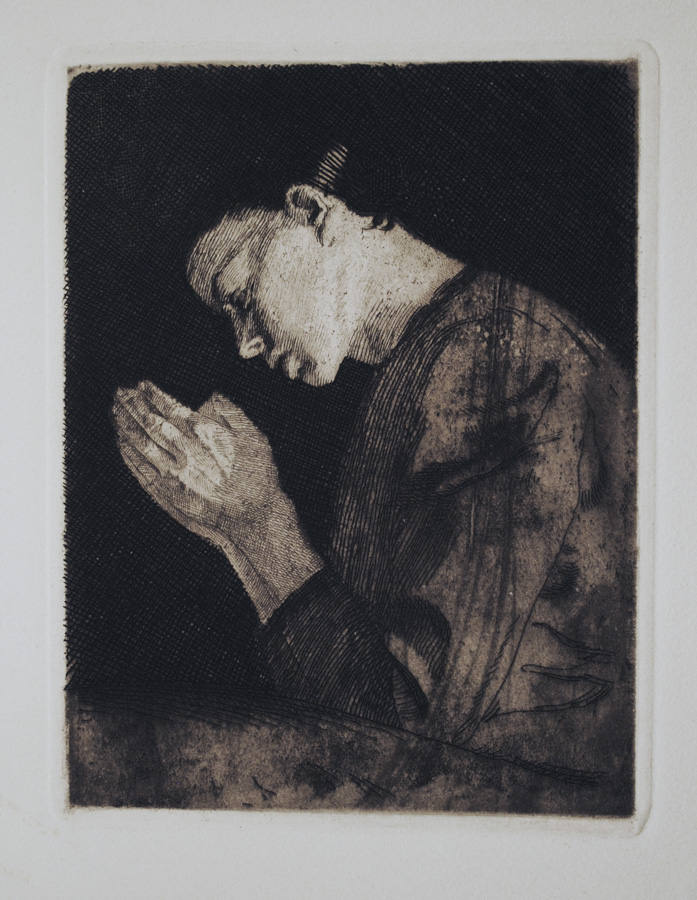 |
|
Betendes Madchen / Praying Girl (Klipstein 11; Von Knesebeck 14 IVb). Original etching, 1892. Edition: a very rich impression printed by von der Becke between 1931 and 1941 after the inscriptions were removed but before the additions of a quatint tone work and fine needle work sometime before Kollwitz' death in 1945. This is a tender portrait of a devout young whose hands seem to be offfering up her prayers to g\God in what may be Kollwitz' variation upon Dürer's famous drawing of a pair of praying hands.. Image size: 196x150mm. Price: Please call or email for current pricing information.
|
|
|
|
 |
|
Betendes Madchen / Praying Girl (Klipstein 11; Von Knesebeck 14V). Original etching, 1892. Edition: a very rich impression from the von der Becke edition after 1945 with his 3-line Berlin-Halinsee drystamp, but before the impressions with his 2-line Muenchen drystamp. Image size: 196x150mm. Price: Please call or email for current pricing information.
|
|
|
|
|
 |
|
|
An der kirchenmauer / By the Church wall: Self-Portrait (Kl. 19 VIb). Original etching, 1893. Edition: from the von der Becke edition after 1945 with his drystamp. According to Otto Nagel, author of the standard works on Kollwitz' self-portraits and on her drawings, although based upon a woman she saw, she has given the woman in the print her own features, making this is a self-portrait. Image size: 215x129mm. Price: Please call or email for current pricing information.
|
|
|
|
|
|
|
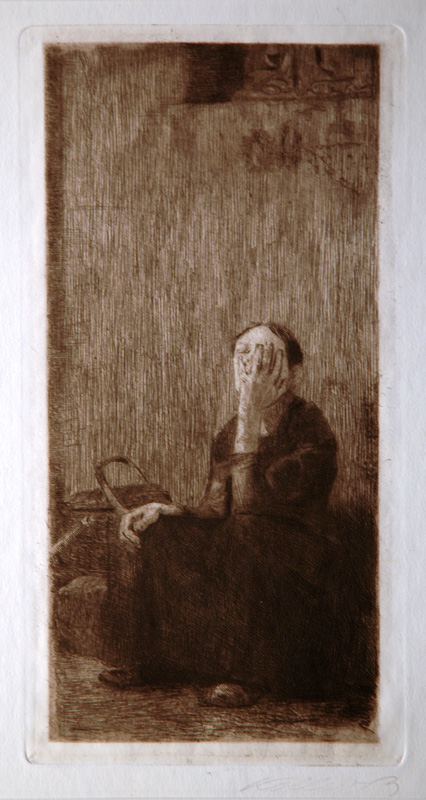 |
|
An der kirchenmauer / By the Church wall: Self-Portrait (Kl. 19 VIb). Original etching, 1893. Edition: from the von der Becke edition after 1945 with his drystamp and the signature stamp in violet. According to Otto Nagel, author of the standard works on Kollwitz' self-portraits and on her drawings, although based upon a woman she saw, she has given the woman in the print her own features, making this is a self-portrait. Image size: 215x129mm. Price: Please call or email for current pricing information.
|
|
|
|
|
 |
|
Das Bangen / Fear (Kl. 126 iib). Original lithograph, 1914. 20 signed and numbered impressions plus an edition published in Kreigzeit (October 1914), of which ours is one. Signed in the stone. Slightly lightstruck; laid down on a support sheet. A haunting image of a mother or wife waiting to hear the fate of her loved ones, herself seeming to be in her funeral shroud. Image size: 330x247mm. Price: Please call or email for current pricing information.
|
|
|
|
|
|
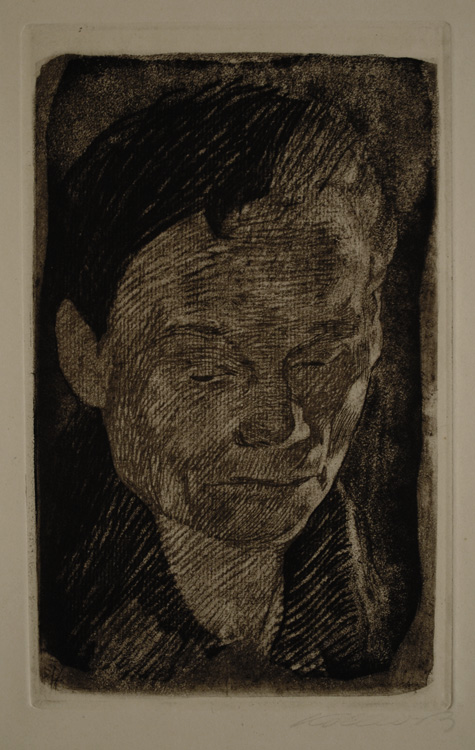 |
|
|
|
Frauenkopf / Head of a Women (Kl. 76v, von Knesebeck 93 Vb). Original etching, drypoint, aquatint, sandpaper and soft ground with the imprint of ribbed laid paper, 1905. In addition to earlier signed editions, there were editions between 1946/48 and 1963/65, in brown or black on various papers, among which lightly yellow or yellow-brown imitation Japan, later on thick, soft velin, some (as ours) with von der Becke’s stamp of the artist’s signature and/or with von der Becke’s three-line Berlin-Halensee embossed seal (ours does not have the seal). Image size: 230x141mm. Price: Please call or email for current pricing information.
|
|
|
|
|
 |
|
|
|
|
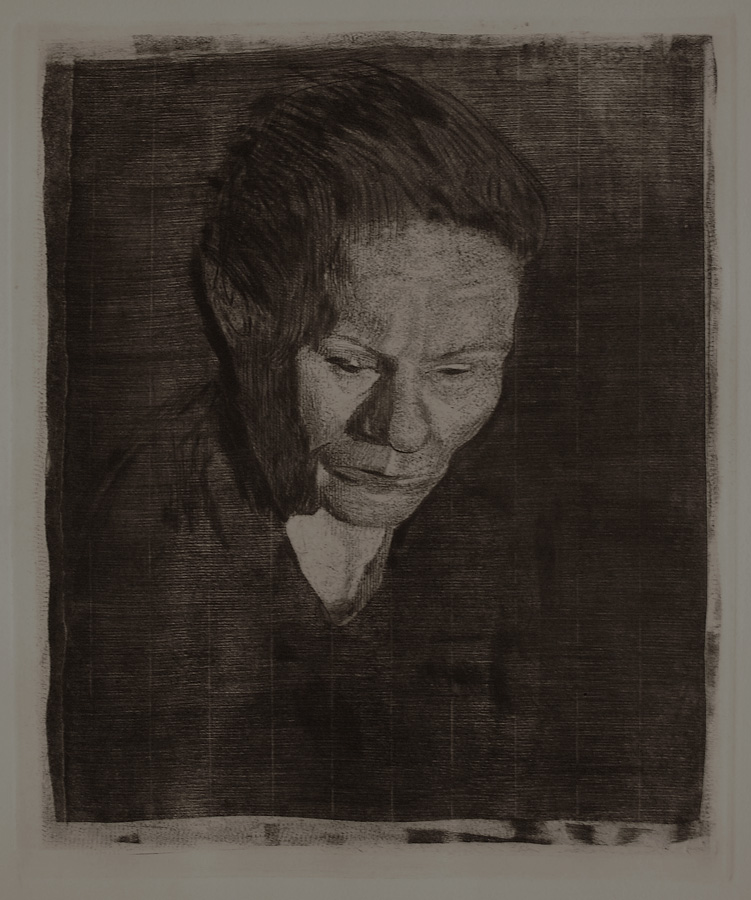 |
|
|
|
Gesenkter Fraenkopf / Head of a grieving woman (Kl. 77 v/v, von Knesebeck 94 ). Original softground etching, c. 1905. Published by Von der Becke, Berlin, with the blindstamp lower right. Very good impression on cream laid paper. One of Kollwitz' most illustrated works. Image size: 380x319mm. Price: Please call or email for current pricing information.
|
|
|
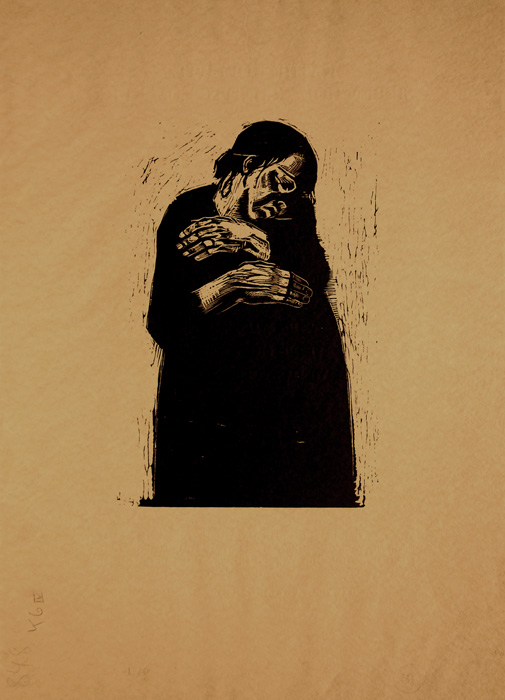 |
|
|
|
Die Witwe I / The Widow I (Kl. 180 V b 1 v; von Kenesebeck 175 V d, Zigrosser 35). Original woodcut, 1921-early 1922. Published in the portfolio Krieg / War. Editions: Proofs before the Richter edition, most on thick, soft, rough Japan. Signed, most titled (State Va). Vb: 100 proofs, hand-printed by rubbing, numbered 1/100 to 100/100 at lower left, signed "Käthe Kollwitz” in lower right, on imperial Japan, approximate sheet dimensions 550/540:470/450 mm (edition A). This edition of the War series is the only one to appear in a portfolio; see von Knesebeck 173 IV b. StateV.c. 100 proofs, hand-printed by rubbing, numbered B 1/100 to B 100/100 at lower left, signed "Käthe Kollwitz” in lower right, on rough, soft velin (edition B). The "B” before the numbering frequently is absent. StateV.d. 100 proofs on the cover of the portfolio (edition A), on hammered paper (of which ours is one). These proofs must have been printed after those of the editions A and B, for the block has a horizontal split above the ear and to the lower right of the mouth. There are some old pencil notations on the lower part of the sheet well away from the image; see below for the window as matted. On the verso (the table of contents for the portfolio) is is the number "30" in the space for the number of the portfolio (see below). One of Kollwitz' masterpieces! The overall sheet size is 673x485mm (26-1/2x19-1/8 inches). Image size: 370:225/235. Price: Please call or email for current pricing information.
|
|
|
|
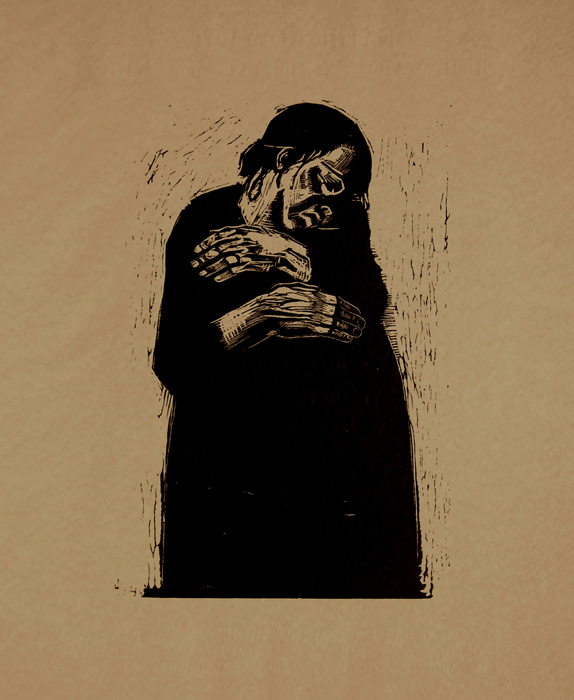 |
|
Close-up of Die Witwe I / The Widow I (Kl. 180 V b 1 v; von Kenesebeck 175 V d, Zigrosser 35).
|
|
|
|
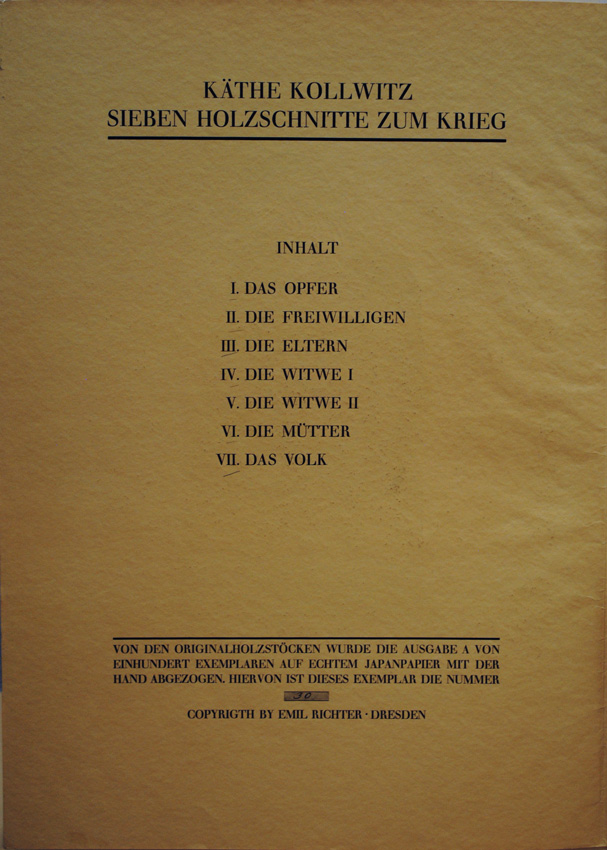 |
|
Die Witwe I / The Widow I (Kl. 180 V b 1 v; von Kenesebeck 175 V d, Zigrosser 35). The portfolio's cover is an impression of the woodcut above; the interior (the reverse of the print above) provides a table of contents and the edition number (see below for detail).
|
|
|
|
|
 |
|
Spaightwood Galleries, Inc.
To purchase, call us at 1-800-809-3343 (1-508-529-2511 in Upton MA & vicinity) or send an email to spaightwood@gmail.com.
We accept AmericanExpress, DiscoverCard, MasterCard, and Visa.
We also accept wire transfers and paypal.
For directions and visiting information, please call. We are, of course, always available over the web and by telephone (see above for contact information). Click the following for links to past shows and artists. For a visual tour of the gallery, please click here. For information about Andy Weiner and Sonja Hansard-Weiner, please click here. For a list of special offers currently available, see Specials.
All works are sold with an unconditional guarantee of authenticity (as described in our website listing).
Go back to the top of this page.
Visiting hours: Saturday 10:00 am to 5:00 pm and Sunday noon to 6:00 pm and other times by arrangement.
Please call to confirm your visit. Browsers and guests are welcome.
|
|
|
|
|
|
|
|
|
|
|
|
|
|
|
|
|
|
|
|
|
|
|
|
|
|
|
|
|
|
|
|
|
|
|
|
|
|
|
|
|












